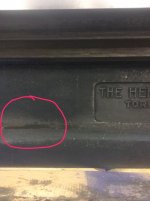Bravotroop
Plastic
- Joined
- Jan 27, 2020
- Location
- USA
Hello everyone. I just joined Practical Machinist. I'm Head Machinist for a classic-car restoration shop. I have got our Hendey 12x5 lathe #24406 working nicely. I would appreciate very much any info on its history. Boss said "paint it like original." I'm no painter, but the body/paint guys are so busy that I have to paint the machine. Took the headstock and tailstock down to bare cast iron. Priming and finish-coating were successful. Took the base and legs down to a layer of softish black stuff, like some kind of glazing, but I did not do the tedious removal of it, or the white Bondo-ish filler I found in some of the casting voids. Primer didn't stick. How did Hendey originally prime over this black stuff? Thanks. If I'm repeating an old question, I apologize.




